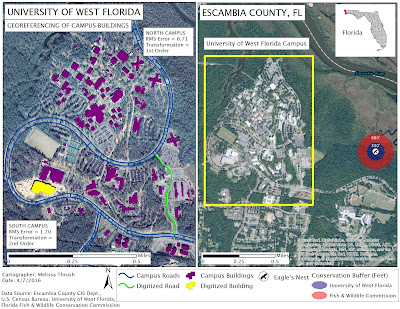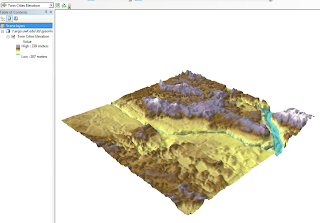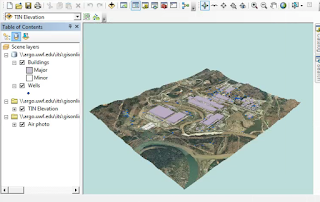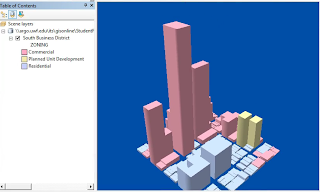 |
| GIS3015 - Final Project - 2014 SAT Results |
Well it's here! My last blog entry for GIS3015. What a journey it has been returning to school after so many years and online!
Our final project assignment tasked us to be an employee of the U.S. Dept. of Education's National Center for Education Statistics. The Washington Post is working on an article about 2014 SAT results and need a map of the data results to accompany their article. Specifically, we've been asked to create a single map showing 2014 mean composite SAT scores and student participation rates for the entire United States, including the District of Columbia. The map will employ two different thematic methods to present the data and show correlation of data sets, if any. The map will aid readers of the Washington Post in interpreting the provided results of the 2014 SAT exam.
For my map I chose to use a choropleth map to show the 2014 mean composite SAT scores by state. The fifty United States and the District of Columbia are shaded by intensity proportional to the mean composite score associated with each state. Using the Color Brewer website I selected a sequential multi-hue color scheme the unipolar mean score data from low to high values. Because the map would be viewed by a wide audience and in print I made a selection that was color-blind safe and print friendly. Graduated symbols were used to represent the differences in magnitude between the percent participation rates among graduates who took the 2014 SAT exam. Because participation rates ranged from 2%-100% a range of data values could be represented by a specific symbol size using graduated symbols and make the data less difficult to interpret.
The Natural Breaks classification method was used to classify the mean composite score data into five classes. This method grouped similar data point values together while also providing enough data points in each break. I originally classified the percent participation rate data using the Natural Breaks method as well. Five classes created interval ranges that were too large. Six classes provided better groupings for analysis. I used the Manual method to modify the Natural Breaks method slightly by adjusting the break values that would clearly show the difference in symbol size in relation to the percentage differences.
The focal center of this map was the contiguous United States. I used an Albers Equal Area Conic projection and reprojected the same shapefile to Alaska Albers Equal Area and Hawaii Albers Equal Area to create data frames for Alaska and Hawaii. These two additional data frames enabled me to effectively use map space and to orient the two states on the map relative to their true geographic locations. An inset map was also added to enlarge the upper Mid-Atlantic and New England region that was densely populated with graduated symbols due to the small geographic area. The inset map required that I identify the area being enlarged on the contiguous data frame. I used the Inner Glow effect to "lighten" the choropleth symbology as well as the Transparency tool to decrease the opacity of the graduated symbols. The inset map provided its own challenges due to the large area which needed to be displayed within limited map space. The areal units for Rhode Island, Delaware, and the District of Columbia were very small comparatively to the rest of the map and the graduated symbols obscured large portions or all of the enumeration units. Using the Pathfinder Divide tool I was able to create three separate segments from overlapping graduated symbols that appeared similar to Venn Diagrams. This tool enabled me to then use Transparency to alter the opacity once again so the colored enumeration units underneath would not be obscured.
Displaying just the mean composite scores on the United States map, the map audience might make biased assumptions such as the Midwest has smarter students or better schools because they all had mean composite scores above the national mean of 1590. However, when the data was displayed alongside the student participation rate the map audience may make a different interpretation. 19 of the 23 states with the highest composite mean scores had 8% or less participation from their high school graduates. Conversely, 22 of the 23 states with the lowest composite mean scores had participation rates greater than 54%. The three locations with 100% participation, Delaware, Idaho, and the District of Columbia also had the three lowest mean composite scores. Noteworthy states were Massachusetts, Connecticut, and New Jersey which had student participation rates of 84, 88, 79% respectively and also had the 25th, 31st, and 30th highest mean scores.
By using both choropleth mapping and graduated symbols to represent the data sets on one map we more easily communicate the data and show the correlation between the two and prevent the audience from making assumptions without understanding the relationship between the data.
This assignment enabled me to use skills acquired throughout the semester to create a map for a realistic scenario. With each assignment, I gained new insight into the world of cartography and realized its power to convey information in both a positive and negative way. We live in a world that wants to rank and make comparisons, especially in public education. This course has enabled me to see how immensely helpful maps and GIS can be in providing the end user the information they need to make thoughtful decisions.
Thank you for helping this Cartographic Neophyte enter this journey towards certification and gain a solid foundation of understanding to prepare for future courses and experiences.









